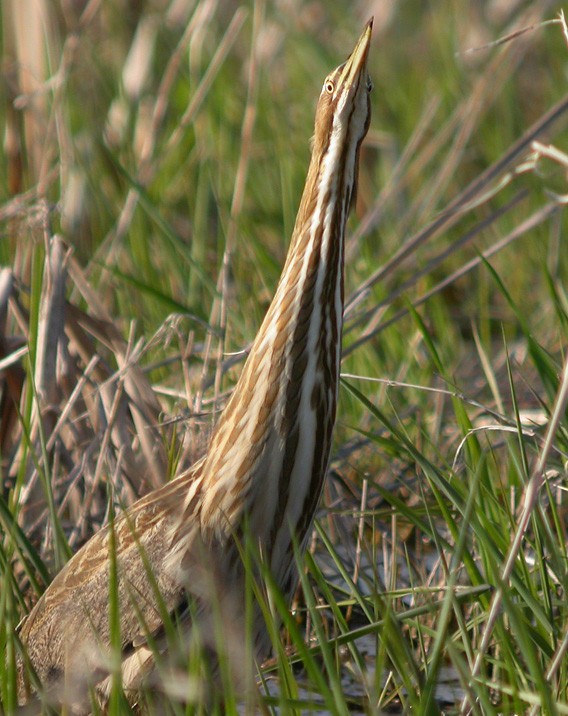Exploring the outdoors at night offers a unique auditory experience. While many creatures remain silent, others come alive, filling the darkness with their calls, songs, and rustlings. This guide focuses on identifying common night sounds, particularly those made by birds, frogs, and mammals, to help you understand the nocturnal soundscape.
Marshbirds: Nocturnal Vocalists of the Wetlands
Several marshbird species are active both during the day and night, making them prime targets for nocturnal surveys. These birds are often most vocal in the early morning or late evening, providing excellent opportunities for detection. While playback can be helpful, it’s important to use it judiciously, especially with threatened species.
American Bittern
The American Bittern’s distinctive “song,” often described as a pumping sound, resonates across sedge marshes and cattail wetlands. These birds favor large wetland complexes or clusters of smaller wetlands for breeding. Their calls can carry for over a mile, so avoid double-counting individuals and ensure accurate block coding.
Least Bittern
The soft calls of the Least Bittern can be challenging to identify, potentially being confused with cuckoos or frogs. They prefer cattail marshes with pools of water but may also inhabit sedge marshes with open water. Look for their sharp alarm calls, especially during July when juveniles are active and family groups communicate.
Sora
The Sora, a common secretive marshbird, inhabits various wetland habitats. Highly responsive to playback and other loud noises, including at night, the Sora’s “whinny” serves as its song. Be cautious when identifying them by call if Spring Peepers are present.
Virginia Rail
The Virginia Rail, another common statewide species, occupies most wetland types. Its advertising song is given in spring, while grunt calls are common throughout the spring and summer. Highly responsive to playback, they typically give the grunt call in response.
Yellow Rail
A very rare resident, the Yellow Rail inhabits sedge marshes and bogs, primarily in the northern half of the state. Its rhythmic clicking sound can resemble a cricket frog, spring peeper, or an insect. This primarily nocturnal species is most likely to be heard during twilight or after dark.
King Rail
Another rare but possible species, the King Rail can be found in almost any wetland habitat. While most likely to vocalize in the evening or morning, they can also be heard at night, especially in response to playback. Listen for the repeated “kek-kek” or “kek-burr” song for positive identification.
Nocturnally Active Sparrows: Songs in the Night
Several sparrow species, particularly those in the Ammodramus genus, vocalize at night as much or more than during the day.
Le Conte’s Sparrow
The highly nocturnal Le Conte’s Sparrow has a soft, buzzy song that can resemble an insect. These sparrows are most likely to be found in large sedge marshes or floating bogs in the northern part of the state.
Henslow’s Sparrow
This sparrow calls throughout the night during the spring, preferring drier habitats such as grasslands with a dense litter layer. Their soft song is easier to hear at night when there is less competition from other birds.
Nelson’s Sparrow
The Nelson’s Sparrow, one of the rarest breeding sparrows, is quite vocal at night, potentially even more so than during the day. Its soft, hiccup-like song can be difficult to distinguish.
Other Bird Sounds: Unexpected Nocturnal Vocalizations
Beyond marshbirds and sparrows, other bird species may contribute to the night sounds.
- Common Loons: Their haunting wails carry long distances across lakes.
- Grebes (Pied-billed and Red-necked): These species make noise at night, often near large wetlands.
- Common Passerines (Swamp Sparrows, Sedge Wrens, and Marsh Wrens): These birds will occasionally sing at night.
- Thrushes (Hermit, Veery, Wood, Swainson’s): Often give call notes at dawn or dusk.
- Ovenbird: This species has a night flight song that can be heard at or after dusk.
- Black-billed Cuckoo: Can be regularly found at night giving calls.
Very Rare Birds: The Unlikely Encounter
Keep an ear out for the calls of very rare owls and marshbirds. Species such as Great Gray Owl, Barn Owl, Northern Hawk-Owl, Boreal Owl, and Black Rail are very unlikely to be found but possible. However, it is very easy to misidentify a species, so confirm before reporting.
Frog Choruses: Amphibian Anthems
Frogs are prominent contributors to the night sounds, especially during the spring. Different species have different habitat preferences and seasonal activity periods. Sometimes, large concentrations of frogs can create an almost deafening chorus.
- American Toad
- Spring Peeper
- Western Chorus Frog
- Wood Frog
- Green Frog
- Bullfrog
- Northern Leopard Frog
- Mink Frog
- Blanchard’s Cricket Frog
- Eastern Gray Tree Frog
- Cope’s Gray Tree Frog
Mammal Sounds: Beyond the Barking Dog
Mammals also contribute to the night sounds, including:
- Coyotes: Howls and yips, often in groups.
- Wolves: Lower-toned howls.
- Deer: Alarm snorts or wheezes.
- Flying Squirrels: High-pitched calls.
Understanding and identifying night sounds opens up a new dimension of appreciation for the natural world. By learning to recognize the calls of birds, frogs, and mammals, you can gain a deeper understanding of the nocturnal ecosystem.
